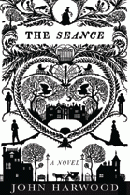 |
John Harwood THE SEANCE Jonathan Cape, 294 pp. Source: review copy Review by Perry Middlemiss |
With one foot firmly planted in superstition and folklore, and the other striding out towards science and enlightenment, the Victorian era is the perfect setting for the gothic or horror genres. The 18th and 19th centuries had seen advances in the physical, biological and mathematical sciences but these had scarcely had any impact upon the general public until the invention in the 1870s of the incandescent light bulb, and the development of the long-life version by Thomas Edison in 1880. The use of electricity rapidly expanded over the following decades and it is interesting to contemplate the reactions of people when they first came into contact with it. It must have seemed incomprehensible - a force that can provide heat and light, yet which could also kill and injure in ways that would have appeared almost magical.
Little wonder, then, that people attempting to come to grips with the new "magic" might turn to old "magic" to define or make sense of it. John Harwood's second novel, The Seance, sits directly in this time period - the late 19th century - when science was making inroads into everyday life, and yet superstition and fear still held sway.
The novel deals with mistaken or lost identity, inheritance and sudden death, deserted, crumbling mansions and dark, forbidding woods. All the classic ingredients of a gothic story that leans in the direction of horror.
Constance Langton has spent the past few years of her life attending her widowed mother who has been pining for a younger daughter who died, and who later commits suicide. Constance is troubled by the part she played in her mother's attempts to contact the dead girl via paranormal means, and feels partly responsible for all that has occurred. In 1889 she learns that a distant cousin has left her a crumbling mansion in Suffolk. Her lawyer, John Montague, presents her with a bundle of papers that detail the lead-up to some shocking events that took place in the hall some twenty years previously. The papers are the personal accounts of Montague himself and Eleanor Unwin whose story seems to bear a resemblance to Constance's own.
The story is complicated and requires close attention, but it is just as much the evocative writing as the plot that holds our interest.
Monks Wood came upon us with no warning, looming like a black waveEmotional and manipulative? Of course. And so it should be. A very distinct part of the gothic tradition lies in the manipulation of the reader's and characters' emotions, leading both along twists and turns, down blind alleys and into scary dark corners. Don't forget that the Victorian era also spawned the classic detective fiction of Doyle and Poe. It was all manipulative, and all the better for it. Harwood knows what he is doing here: he'll spook you a bit, and seem to deceive you with sleight of hand from time to time, but you always have the feeling you are in safe hands and that you won't be left hanging over a pit, suspended only by a slowly fraying rope.
out of the mist as we passed from grey daylight into near-darkness beneath the
firs. The rushing of the wind ceased, and there was only the muffled rumble of
the wheels, the scrape of branches along the carriage, and the occasional gush
of water from the foliage above. Shadowy outlines of tree trunks slid by, so
close I could have touched them. The knot in my stomach tightened still
further as the minutes dragged by, until the light returned as abruptly as it
had gone.
Two years ago we were lucky enough to read another Australian gothic novel, The Resurrectionist by James Bradley. That was a gem, and so is this. John Harwood's previous novel, The Ghost Writer, won the Best First Novel Award at the International Horror Guild Awards. This one should surely be in contention for the main award.
